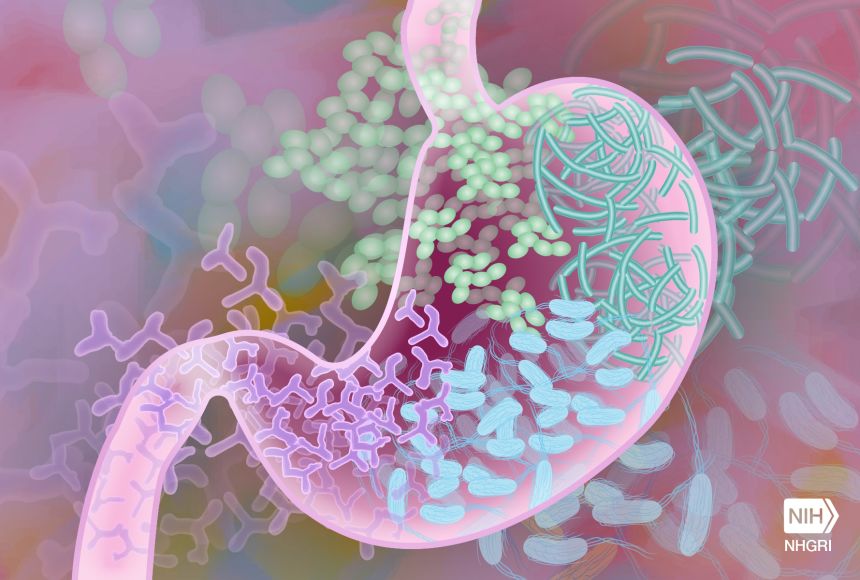A rich collection of bacteria lives in our guts, or intestines, and plays an important part in digestion. Part of our gut produces digestive enzymes, which are substances that help break down food. Sometimes, our enzymes can't deal with certain foods, like beans. That's when our gut bacteria step in, chomping down on those bean molecules and creating gas in the process.
But gut bacteria do much more than play an essential role in human nutrition. The key to whether we're fat or thin, cheerful or depressed, and healthy or chronically ill, may lie in the gut microbiome. A microbiome is the collection of microorganisms, like bacteria, in a particular place. Your gut's microbiome is home to hundreds of species of bacteria.
Poop Is Everywhere, But That's A Good Thing
We start accumulating our gut bacteria at birth, when we pass through the mother's birth canal. We pick up even more bacteria through our mother's milk, which contains substances that can only be digested by bacteria specifically by a bacterium called Bifidobacterium infantis. This is a helpful bacterium that makes itself at home in the baby's digestive tract and helps prevent infections.
Milk does not just feed the baby, but it also functions as a probiotic, or a substance that helps good bacteria grow. In addition, milk is a prebiotic, meaning that it supplies your gut bacteria with something to eat.
Generally, by the time kids turn three, when they are eating solid foods and crawling around on the floor, their internal microbiomes are fully established. This means that they have come in contact with large numbers of fecal particles, that is, bits of poop. According to scientists who study microorganisms, the environment is pretty much coated in fecal particles.
Although this might sound creepy, it's a good thing. The bacteria that we pick up can provide us with enzymes and vitamins, such as vitamins B and K. They also help us battle infections and manufacture chemicals that are important for our mental health and well-being. For example, serotonin is a chemical that your nerve cells produce. It affects your mood, appetite, sleep, memory and learning. Ninety percent of the body's serotonin is made by gut bacteria.
Junk Food Can Kill Off Good Bacteria
Our personal bacteria also protect us from a wide range of illnesses. Scientists think that the increase in some sicknesses in the population means that something is going seriously wrong with these bacteria. The modern rise in the number of people who are overweight, have allergies, asthma, arthritis, diabetes and anxiety attacks may be related to the bacterial populations in our guts.
The cause might be a leaky epithelium. The epithelium is the important lining of the digestive tract, and it usually acts as a barrier between the gut bacteria and the rest of the body. Bacteria ordinarily keep epithelial cells healthy by providing them with nutrition, but without the right nurturing bacteria, the epithelium breaks down, allowing some bacteria and toxic bacterial by-products to enter the bloodstream. This sends a signal to the immune system, alerting it to the presence of invaders, which can lead to persistent inflammation and eventually, diseases.
In industrialized nations like the United States, a sanitized lifestyle and a diet heavy in processed foods have killed off some of our body's microorganisms. So have antibiotics, which are medicines that fight against bacterial infection. The result is a microbiome that has lost many helpful types of bacteria. Many modern diseases may be occurring because our microbiomes aren't what they used to be.
A diet of junk food doesn't do our bacteria any good, either. Tim Spector is a scientist who studies diseases. In an experiment, he convinced his adult son to spend 10 days on a dedicated fast-food diet of fries, burgers, chicken nuggets and Coca-Cola. By the end of 10 days, he had lost one-third of the bacterial species in his gut.
Exercising, Eating Fiber-Rich Foods Can Help
So how can you maintain a healthy gut microbiome? Scientists and doctors say that you should not depend too much on the probiotic supplements available in the market. Instead, they recommend a diet rich in probiotic fermented foods, or foods in which the molecules are broken down by yeast or bacteria. Examples include yogurt, sauerkraut, kimchi and miso soup. They also recommend fiber-rich foods, like whole grains, fruits and vegetables. It is also a good idea to avoid processed foods, which do not provide much nourishment for your gut bacteria.
Exercise also seems to benefit our guts. In one study, researchers compared rugby players to nonathletes and found that the rugby players had more diverse microbiomes, with higher proportions of at least 40 different bacterial species.
We should also be cautious about overusing antibiotics, even though there are certainly sometimes necessary. Studies show that that the gut microbiome can take up to a year to bounce back after a course of antibiotics, which can wipe out lots of bacteria, both good and bad.
Finally, you might want to expand your environment, because the more diverse bacteria you pick up, the better. So meet new people, pat the dog, dig in the garden and play in the dirt.

